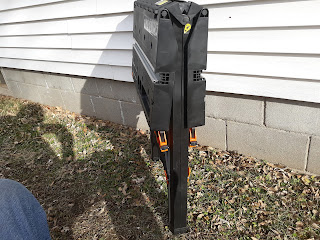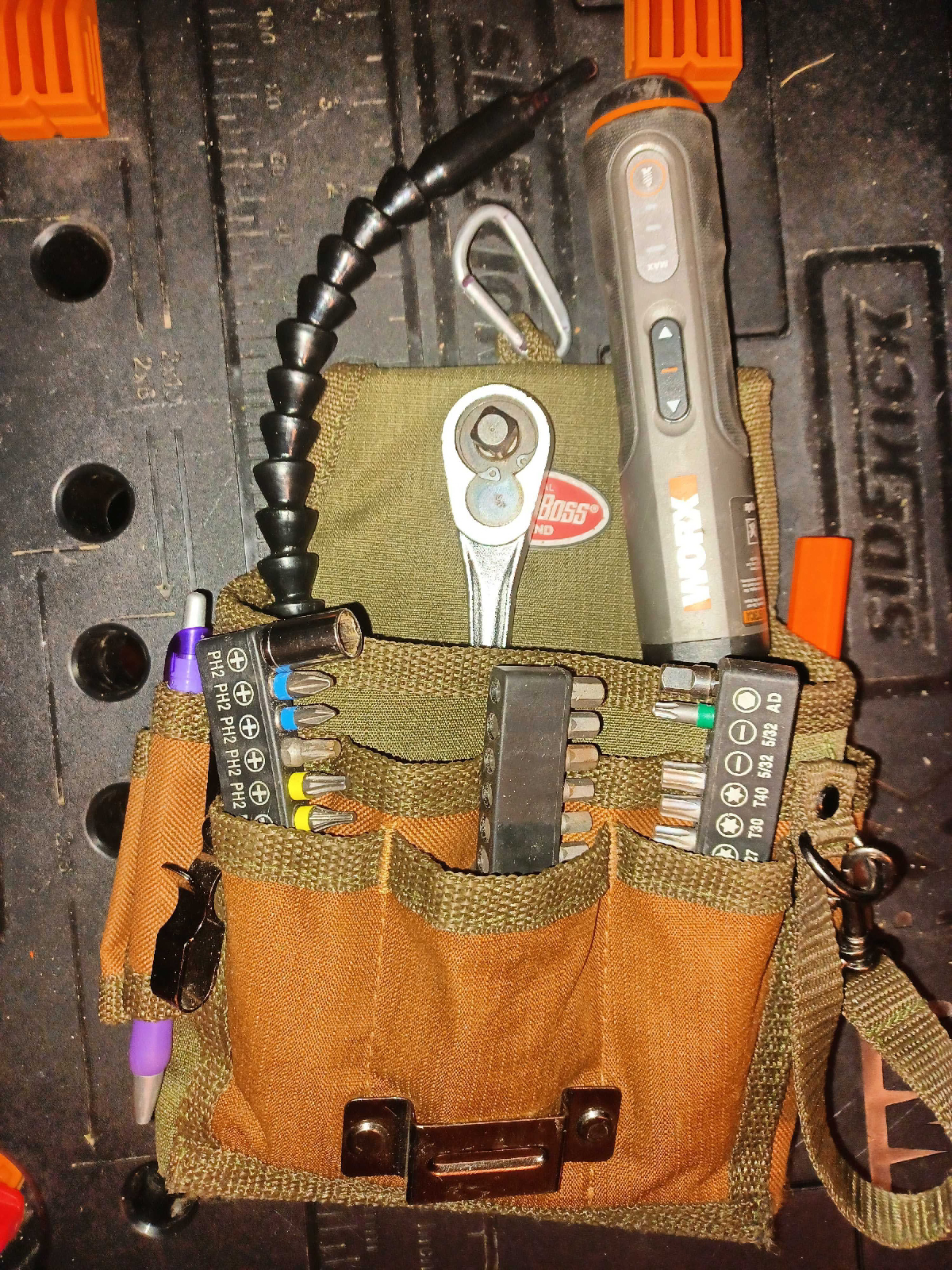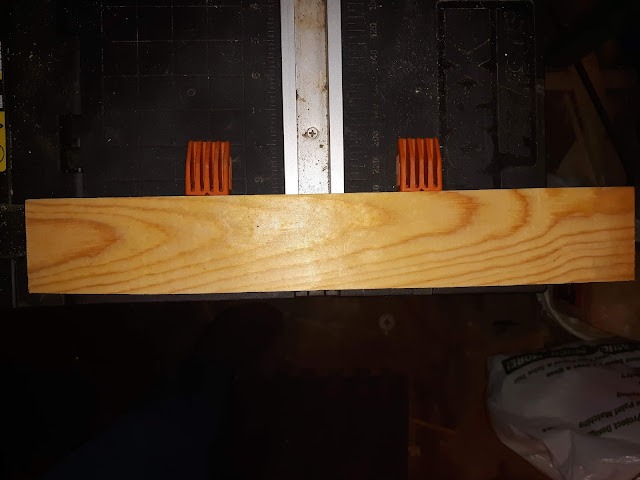Work Support: Worx Pegasus Portable Combo Sawhorse and Worktable
The Review
I've discussed this tool, the Worx "Pegasus", in other articles and videos but not really in the context I think they need to be seen in. This post is going to discuss it from a more comprehensive work support tool perspective.
Sawhorses
So because I use sawhorses to support a lot of my larger assemblies and repairs, the first thing I wanted the Worx Pegasus for was this format. As a sawhorse, they are rated to hold up to 500 pounds per sawhorse. Having 2 of them, they can supposedly support up to 1,000 pounds, that's half a ton, of weight on the pair.
In most of my projects, I don't really need to support that much weight. Most of what I use sawhorses for is to assemble large tables and benches. I do a fair amount of door repair also, but I tend to use my smaller set of portable sawhorses for that. Probably the heaviest thing I use the Pegasus sawhorses for is to assemble steel shelving units that can weigh up to about 400 or 500 pounds.So in assembling the biggest items I work on, which is large dining room tables and similar sized furniture, I have found the sawhorses to be undeniably able to hold the weight without so much as a squeak.
The sawhorses are made of what they say is a non-marring plastic which is mostly true. There have been a few times that on very light colored objects with a bit more complex texture, when some of the black from the plastic has shown up on the product. I've learned to place a couple of old towels over the sawhorses for those kinds of materials since then.
Like any sawhorse, there is a limit to how much weight one can put on the side end of the horse before it wants to tip in that direction. Physics is physics after all. A plus for these sawhorses is the lower shelf that unfolds underneath them when they are set up. They hold a considerable amount of weight. More than I thought they would. By placing a heavy toolbox underneath on the storage shelf, you can gain extra resistance to tipping.
I'm not able to find a specific weight limit in the owner's manual or their online FAQ page but I would guess they would suggest it should hold about 35 lbs based on relatable FAQ answers I saw. Though I've had about 50 pounds under there without a problem.
They have a channel notched into each end so that a 2-by board can be stretched across as supports for a sheet of plywood, etc... That's a good consideration when it comes to using these horses as a support platform.
In regards to overall durability or how much punishment can they take on a jobsite. I have had more than my fair share of bumps, drops, knock-overs and more with these. In my observation, they take a licking and keep on ticking. BUT... I've also had the misfortune of having run over one of these sawhorses with my pickup truck. (Blame my ADHD, it was one of those situations). I can reliably report that the plastic is NOT "truck-proof" at all. There was no salvaging the sawhorse/worktable at all after that.
Now, the caveat here is that as a sawhorse, you're not actually going to do any actual sawing over the tops of the horses. There is no way to attach a sacrificial 2-by to the tops of them. These really are designed to be for support only. So if you're looking for horses to actually use as a cutting platform, I'd look at a different product. I only cut off the outside edges, away from the horse itself.
Worktable
There are 2 "wings" on either side of the table that open up and lock into place to make it a portable worktable. As a worktable, it is rated to hold up to 300 pounds. As noted in the sawhorse section, this table is NOT designed to be used as a cutting platform. In fact, it is primarily designed with lateral support in mind.
You can use the table with both wings set up or with only one side set up, One side up has it's uses. Also, using the F-clamps and bench dogs on a down side can also be useful.
There are 2 T-tracks built into the table that allow the 2 F-clamps that come with it to slide and lock in place. The clamps open up to about 18 inches wide open and can clamp closed with a claimed 300 pounds of force. If you plan to use this for glue-ups, make sure to place some kind of wax paper or similar down beneath the material being glued first.
In addition to the 2 F-clamps, the table arrives with 16 holes of 3/4" diameter molded into the table in a grid format. These are for the 4 "bench dogs" that also come with the unit. The bench dogs also help prevent lateral (side-to-side) movement and can work in conjunction with the F-clamps in the tracks to accommodate off-sized materials you're working with. The bench dogs are also very nice to set up as a back rest to press materials against as you apply pressure or simply to keep things from sliding off the table as you work.
The surface of the table has a molded in layout grid lines and molded in measure as well.
You can also use the clamps to hold things down to the table. But here is where I've found some of the best benefit of this worktable. By using a combination of the clamps and the bench dogs, you can use the table as a stand for a variety of powered tools. I attach my powered Mitre saw, manual mitre box, portable table saw, portable router table and more such tools to the table all the time on job sites.
In fact, taking the presence of the formed bench dog holes a step further, I created a couple of bench dog size "feet" that can attach to any of those tools base to keep them stable and secure but easily added or removed. This has made these worktables exponentially more useful to me in my work as a mobile service provider.
Anything that needs to be attached to the table to keep it from lifting off the table as it's being used is a different story. For example, I have a couple a bench clamps that I use sometimes. It requires that I modify my homemade bench dog feet with large washers at the bottom to clamp on the underside of the table. Though I wouldn't recommend doing that for much more than bench clamps. Anything requiring more force than those use might damage the table. Again, it's primary design seems to be to prevent lateral movement. Which is honestly fine for the majority of ways I need to use it for.
For someone who needs more up-and-down force or pressure needs, this might not be as useful. And again, it shouldn't be considered as a cutting support
I mentioned earlier about these not being designed for cutting on the surface. In worktable format, I only cut off the outside edges or using 2 of the tables together, cut through the gap between them.
Next up are the molded in "pockets" or "trays" on the table surface. There are 2 small trays and 1 large tray on each side of the table. I find this extremely useful in assembly and small appliance repair. I can have a place for hardware and small tools that sit below the surface of the table and won't damage the item as I work on it on the table. Keeping these small pieces right there at hand while I'm fixing or building is a terrific consideration in the design of the table.
In connecting the tables though, always keep an eye out that they are on a flat and level surface. Otherwise they will have difficulty staying together. The legs are not adjustable in any way so mind where you set up at. I always have shims on hand anyway.
The Rating
In regards to being useful, durable, flexible tools, I'll give the sawhorse function a B plus. I don't use the typical rating system that typical reviewers use in regards to if a tool is "Pro" level or DIY, or Home level. Instead, I categorize them as "Heavy Duty". "Mid Duty", and "Light Duty". As users in the Pro, DIY , and Home categories can frequently have need for different qualities and capabilities in tools. I base the rating on the work and how it's used instead.
In that regard, The Worx Pegasus combination Sawhorse and worktable falls into the "Mid Duty" ranking. In this, I expect that for probably 75% of the most common tasks that people use a tool like this, should find it able to meet those needs.
Durability: They are pretty well made and take some amount of punishment but won't take outright abuse. If these are being used on busy job sites by careless users or needed for tasks requiring high amounts of force or pressure or weights over 1,000 pounds, then you need to look for a Heavy Duty type. If you are an installer, or a specialist of most types and you are the only one using it not in a careless way, this can be a very good support tool on a less busy job site.
Usefulness: It's molded in trays, bench dog holes, that it comes with decent F-clamps and bench dogs helps a lot. Since it's design seems to be focused more on preventing lateral movement, this might not be as useful to a framer or mostly direct cutting need. Also, it's best used in a location with finished or flat surfaces, not on uneven ground. But for a finish carpenter, installer, assembly, flooring, etc.. that might need a tool that can be used to put a mitre saw or some other power tool or to hold things in place while working on them, I think it's very good.
Flexibility: In a rough environment, it is much more limited as mentioned above. But in a flat surface working area, It's ability be used in multiple configurations and with such a variety of positions makes it able to do a lot of different things. Being fairly lightweight, it's portability makes it pretty easy to take along anywhere. Again, for people working as installers, finish work, assembly, and related tasks and jobs, The Pegasus does a number of different things,




















Comments
Post a Comment